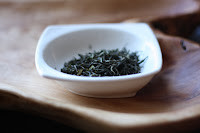 Tea: Xue Ya Ballad
Tea: Xue Ya BalladVendor: Adagio Teas
Price: $9/ 3 oz.
Source: Keemun, China
Vendor Description: An early spring harvest green - unusual for the Keemun region - this tea features gentle chestnut notes and complex fruit-like, mellow sweetness with a delicate yellow cup color. Once you have heard its lovely notes, you will return to it again and again.
Leaf: The leaf for this tea is dark green with some silver hairs to it. Overall the colors of the leaf are rather muted and dull. They are relatively long leaves, with a thin twisting to them. No notable aromas to the dry leaf though.
1st Infusion Parameters: 5g, 5oz, 185F, 45s
 1st Infusion: This tea has a yellow green hue to it. It is lightly murky with a sharp and distinctively Chinese green aroma to it. It can best be described as being vegetal in nature. The tea has some early marine flavors which transition into a pan fired sharpness. There is no aftertaste to speak of, but the core of the flavor is rather bold. It feels somewhat complicated, but at the same time a bit muddled.
1st Infusion: This tea has a yellow green hue to it. It is lightly murky with a sharp and distinctively Chinese green aroma to it. It can best be described as being vegetal in nature. The tea has some early marine flavors which transition into a pan fired sharpness. There is no aftertaste to speak of, but the core of the flavor is rather bold. It feels somewhat complicated, but at the same time a bit muddled.2nd Infusion Parameters: 30s, 185F
2nd Infusion: This infusion has a bolder, stronger yellow color to it. Overall the color is much more intense. It again is lightly murky. This time around though the tea exhibited a medium sense of astringency, but it lacks the marine hues of the first. There is a strong central flavor to be found here with some strong roasted notes to it. It feels very much like a Long Jing without the creaminess.
Rating: 5/10
Conclusion: Overall a fairly average tea, not too expensive, but not too fabulous either. It would probably make for a good staple Chinese green tea if you're looking for one, but personally I would like to stick to something a bit more fantastic.











































